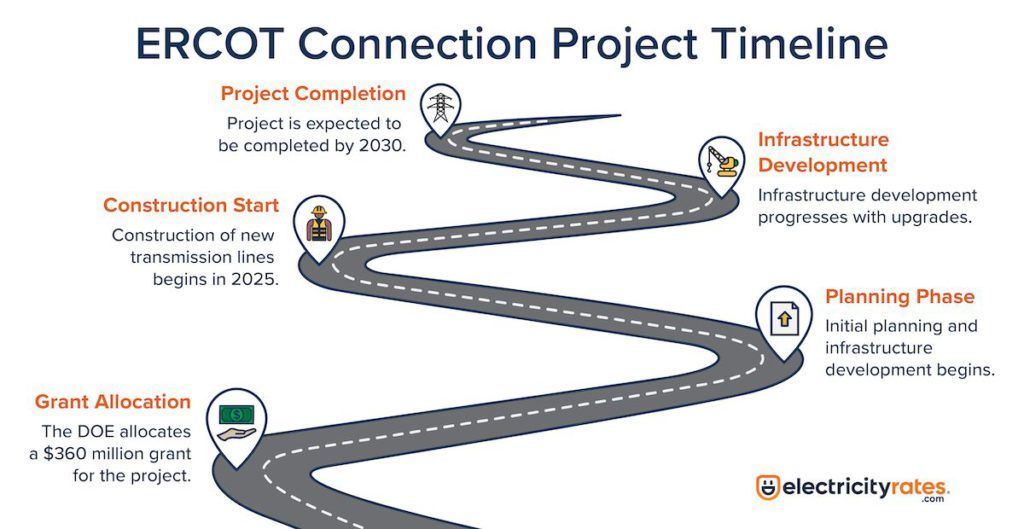The browser you are using is not supported. Please consider using a modern browser.

ERCOT Power Grid Set To Connect To U.S. Grid: What The $360M Project Means For Texas And The Southeast
Advertiser Disclosure:
At ElectricityRates.com, our number one goal is to help you make better energy decisions. We adhere to strict editorial guidelines, however this post may include references to products offered from our partners.
Key Takeaways
- ERCOT to Connect to U.S. Grid: A $360M federal grant will link ERCOT with the Southeastern U.S. grid, improving power reliability and stability.
- Increased Resilience: The connection will reduce rolling blackouts and improve energy sharing during extreme weather events and high-demand periods.
- Cost and Energy Savings: Thanks to increased grid flexibility and resource sharing, Texans and Southeastern residents may see more stable electricity rates.
- Boost for Renewables: The project supports renewable energy integration, allowing Texas to share excess wind and solar power with neighboring states.
Table of Contents

In a giant step for energy security, the infamously independent Texas grid (ERCOT) is preparing to connect to the U.S. grid. The Biden-Harris administration has committed a $360 million federal grant for this vast project as part of their ‘Investing in America’ program.
This new expansion will establish a critical link between Texas’s energy grid and the Southeastern United States. The goal is to increase reliability, reduce power outages, and stabilize energy costs. Keep reading to see what you can expect from this breaking news and how it will affect electricity costs for residents across Texas and the Southeast.
What Is ERCOT? Understanding the Texas Power Grid
ERCOT, or the Electric Reliability Council of Texas, is an independent electricity grid operator that manages the power flow for about 90% of Texas. Unlike most other states, Texas has historically operated its grid separate from the rest of the U.S., mainly for regulatory and logistical reasons. This has allowed ERCOT to avoid some federal regulations, but it also means that Texas has limited ability to import electricity from neighboring states during emergencies.
Why the ERCOT Isolation Matters
Texas’s decision to remain separate from other U.S. grids has implications for grid resilience. During crises, such as extreme weather events, ERCOT’s limitations mean it can’t quickly bring in outside power. This isolation has created vulnerabilities that became painfully clear during Winter Storm Uri in February 2021 when 4.5 million Texans faced extended power outages, drawing attention to ERCOT’s unique challenges and limitations.

The New ERCOT Connection to the U.S. Grid: Overview of the Project
The $360 million grant allocated by the U.S. Department of Energy (DOE) is part of a broader nationwide vision to integrate power grids, known as the “Investing In America” initiative.
Project Timeline and Scope
The project is scheduled to roll out in phases, with the initial stages focusing on planning and infrastructure development. Construction of the new transmission lines is expected to begin in 2025, with an estimated completion date of 2030.
Involved Organizations
The main entities working on this connection include ERCOT, DOE, and regional grid operators from the Southeastern U.S. This collaboration marks the first time ERCOT will have an active, permanent connection with another U.S. energy grid.
Funding Breakdown
The $360 million grant will primarily cover the construction of new infrastructure and upgrading existing facilities. The Southern Spirit Transmission Line – the keystone of this project – will link Texas to the Southeastern U.S. grid.
The Southern Spirit Transmission Line: Bridging ERCOT and the Southeast
The Southern Spirit Transmission Line, a high-voltage line stretching from Texas into the southeastern U.S., will serve as the main conduit for electricity exchange between ERCOT and the larger national grid. Designed to accommodate high power loads, this 320-mile-long line will allow energy to flow between regions during peak demands and emergencies.
Why Now? Understanding the Need for ERCOT’s New Grid Connection
Increased Weather-Related Risks
Over the past few years, the Lone Star State has faced a series of intense weather events, from winter storms to record-breaking summer heat waves. This puts extreme pressure on ERCOT’s capabilities. The demand spikes and power outages revealed the vulnerabilities in an isolated system. With greater interconnectivity, ERCOT can draw on other states’ energy reserves during these high-demand periods.
Growing Energy Demands
Texas has experienced a population boom in recent years. In 2000, there were 20.9 million Texans. By 2020, the population had grown to 29.1 million, with continued growth expected! This drives up electricity demand across residential, commercial, and industrial sectors. By connecting to the U.S. grid, ERCOT can better meet these growing needs without solely relying on in-state generation.
Long-Term Benefits of a Connected ERCOT Power Grid
This connection will substantially benefit homeowners, renters, and business owners across Texas and the southeastern U.S.
- Enhanced Grid Stability: This connection will make both the Texas and Southeastern grids more stable and resilient against outages.
- Cost Savings: Access to cheaper, more abundant electricity will stabilize prices for Texas residents and could help prevent the price spikes that sometimes follow extreme weather events.
- Job Creation: The project is anticipated to create over 850 construction jobs and 305 permanent operations jobs, contributing positively to local economies.
- Environmental Benefits: A larger grid allows for better integration of renewable energy, helping both Texas and the Southeast move closer to national climate goals.
Impact on the Environment and Renewable Energy
Texas is one of the largest wind energy producers in the U.S., and the new connection with the national grid could allow for more efficient distribution of this renewable resource. By exporting excess wind and solar power to other states, Texas can boost the local economy, reduce overall emissions, and strengthen the country’s commitment to renewable energy.
With a direct line to neighboring grids, Texas can export excess renewable energy, reducing the need for fossil fuels in Texas and the Southeast. The ERCOT connection is part of the DOE’s larger initiative to create a greener, more efficient national power system.
How the ERCOT Connection Reduces Rolling Blackouts
One of the main objectives of this project is to reduce ERCOT’s reliance on rolling blackouts to balance demand and supply. During Winter Storm Uri, for example, ERCOT implemented rolling blackouts to prevent a total grid collapse. An interconnected system, however, would allow ERCOT to import electricity from other states during such emergencies, providing a buffer to meet unexpected demand spikes.
Challenges and Risks of the ERCOT Connection
While this project offers significant benefits, it does pose some challenges. Coordination between ERCOT and Southeastern grid operators may be difficult, given differences in legal regulations and management practices.
ERCOT has faced challenges with energy congestion in the past. This occurs when the power grid’s transmission capacity is insufficient to meet the demand for electricity. It happens when the flow of electricity exceeds the limits of the transmission lines, leading to potential overheating and operational challenges. This problem is most notable in the western part of the state, which has large wind farms. Furthermore, infrastructure updates will require substantial investments beyond the initial $360 million grant to ensure both grids can handle the increased load and maintain reliability.
What Comes Next: Timeline for ERCOT’s Integration
The project is set to begin initial construction phases in 2025, with major transmission line work starting in 2026. By 2030, ERCOT and the Southeastern U.S. are expected to be fully connected, marking a historic shift for the Texas power grid.
Conclusion: The Future of the Texas Power Grid
With ERCOT finally joining the U.S. grid, Texans and Southeastern residents alike can look forward to a more resilient, affordable, and sustainable energy future. This move marks a significant step forward for grid reliability, offering peace of mind and economic benefits across the region. As Texas continues to lead in renewable energy production, a connected ERCOT will further support national efforts to create a greener and more reliable energy network.

The Latest Energy News & Resources
-

United Illuminating CT Rate Increase January 2026
Connecticut UI customers face a 17% increase in the Standard Service supply rate (13.695¢/kWh) starting Jan 1, 2026. Learn how this, plus a distribution charge hike, affects your total winter bill and find resources to save money.
More -

PJM Prices Skyrocket Again for the 2025–2026 Delivery Year
AI data centers spike PJM capacity prices to a record high for 2025-26. See the impact on your bill and compare electricity rates to lock in savings today.
More -

Eversource CT Rate Increase January 2026
Get ready, CT! Eversource's Price to Compare (PTC) electricity supply rate is jumping 13% to $0.1264/kWh on Jan 1, 2026. Learn why rates are rising, see bill increase estimates, and find state and utility programs (CEAP, HES) to lower costs and manage payments. Compare plans now!
More